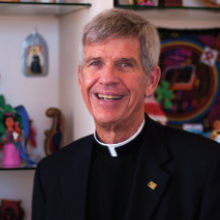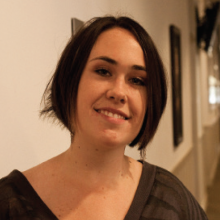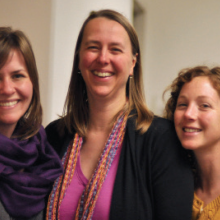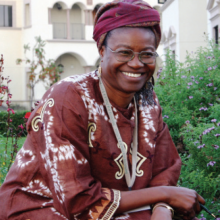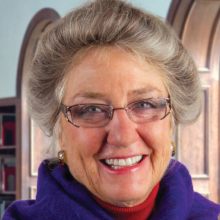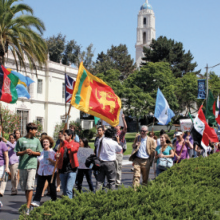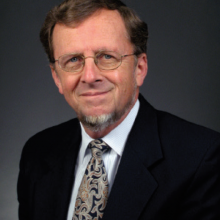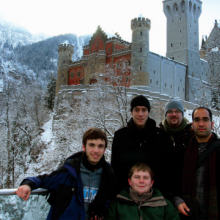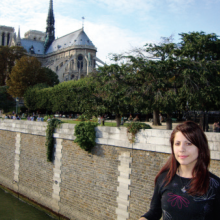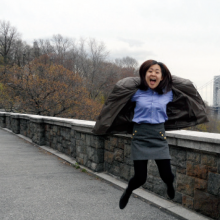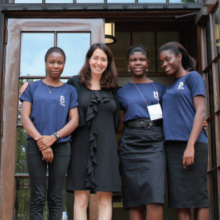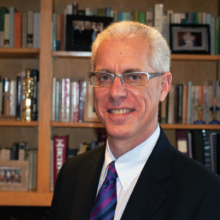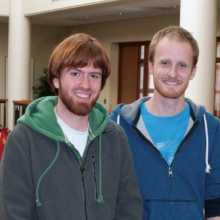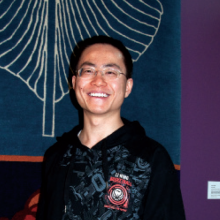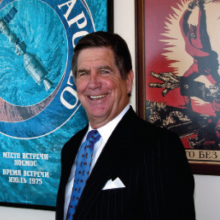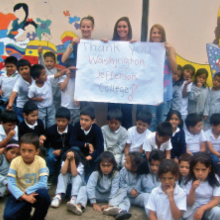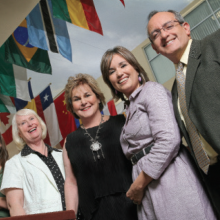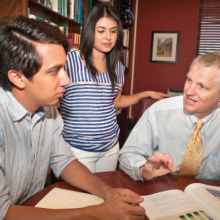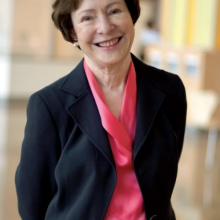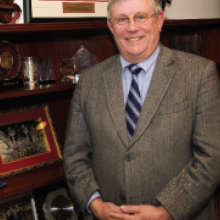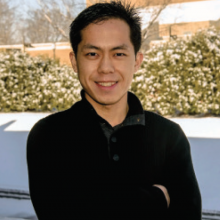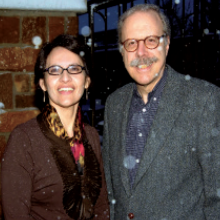2010 Comprehensive University of San Francisco
Few campuses provide a view more dramatic than the panorama of the Pacific Ocean, the Golden Gate Bridge, and the San Francisco skyline afforded by the hilltop, upper campus of the University of San Francisco. Students who come to this Jesuit university can expect to be pushed hard to venture into far less privileged precincts, as near as the streets downtown where San Francisco’s homeless dwell or as far as remote hamlets in Malawi and Guatemala. Sitting in his office atop the Lone Mountain campus, President Stephen Privett, S.J., said, “For us…the global perspective is the realization that about 70 percent of the world lives in dire poverty. I always tell the kids that one person in 100 has a college education, so they’re 1 percent of the world. The ethical question for higher education, whether Catholic, private, public, for profit, not for profit, is: What are you doing for the 99 percent?”
USF became San Francisco’s first college in 1855, when Italian Jesuits opened St. Ignatius Academy after the gold rush. They were following the example of Saint Ignatius Loyola, the sixteenth century founder of the Society of Jesus. In San Francisco the Jesuits educated generations of sons and, later, daughters of immigrants. That heritage endures although today the roster of names is more diverse: not only O’Briens and Giordanos, but Nguyens, Aquinos, and Yangs. After USF’s buildings were destroyed in the 1906 earthquake and fire, classes were held in a drab building dubbed the Shirt Factory, but in 1927 it relocated to the verdant site near Golden Gate Park and expanded in 1978 by acquiring Lone Mountain College, a Catholic women’s school with Spanish Gothic architecture and those priceless views. Today USF enrolls 5,700 undergraduate and 3,500 graduate students in arts and sciences, business, law, nursing, and education. Nearly 10 percent are international students. Located in the city where the United Nations was born, USF set out a decade ago to become “internationally recognized as a premier Jesuit Catholic, urban university with a global perspective that educates leaders who will fashion a more humane and just world.”
USF, once a basketball power (the Dons won back-to-back NCAA basketball championships with Bill Russell and K.C. Jones in the 1950s), now wins recognition for its community service requirement. The 200,000-plus volunteer hours logged by 3,000 students each year has won laurels from the Corporation for National and Community Service.
International Studies the Second Largest Major
The university created an Office of International Student and Scholar Services seven years ago and later opened a Center for Global Education to encourage students to study abroad and pursue professional and service internships overseas. The international studies major launched four years ago quickly became the second largest field of study in the liberal arts. “Students are going crazy for this,” said Jennifer Turpin, the new provost and former dean of the College of Arts and Sciences. The major combines courses from the humanities, social sciences, arts and sciences; education abroad is strongly encouraged but not required. With new hires, USF has added programs in African studies, Middle East studies, and Asian studies. Turpin, a sociologist who studied the role of Russian media in the disintegration of the Soviet Union, said, “Year after year, as I’ve introduced the new faculty, people say it looks like the United Nations is walking in.”
Seniors Emily Saeger and Erica Ernst are two of those drawn to international studies. Saeger, from Washington, D.C., spent a summer teaching in Nicaragua and a semester interning for a nonprofit in Quito, Ecuador, on protecting the Amazon rainforest. Saeger, who double majored in Latin American studies, concentrated in environmental development and is considering a career in that arena. When Saeger enrolled she “didn’t realize how strong the whole social justice mission was at this school and I definitely didn’t imagine myself taking so much out of that. I’m not Catholic or very religious at all. But the thing I like the most about being in a Jesuit university is that commitment to social justice…. It’s felt and seen throughout the classes.”
Ernst went on a two-week USF service trip to Uganda, and then spent a semester studying and working with schoolchildren in the Francophone West African nation of Burkina Faso. She and other students studied digital photography, and then used their skills to make books in French for children about how to use the village library.
“The international studies major launched four years ago quickly became the second largest field of study in the liberal arts. Students are going crazy for this.”
The trip had its trepidations. “After three and one-half months in Burkina Faso, most of us got parasites, and two got malaria. That’s just the reality of going somewhere like that,” said Ernst. Her mother, a nurse back home in Bellevue, Washington, told her, “Just take the medicine. You’ll be fine.” Ernst was homesick at first and overwhelmed by classes taught only in French, but when she went to work in a village it was “almost living in a dream. It was just so beautiful, in the middle of nowhere with the sky and the green grass going on forever.”
Lois Lorentzen, a professor of social ethics in the Department of Theology and Religious Studies and codirector of the Center for Latino Studies in the Americas, has led students on service trips to Cambodia and South Africa. “We don’t send students to super dangerous places; we do semi-dangerous ones,” she said. Recently the university canceled a trip to Tijuana, Mexico, because of drug violence along the border.
A Scholarship for Study in Developing Countries
Education abroad is growing at USF, but remains at modest levels. Some 432 students studied abroad for credit in 2008–09. Sharon Li, director of the three-person Center for Global Education, said students can choose from more than 50 USFsponsored programs that allow them to apply their financial aid toward the expenses. Still, for students who may be working two jobs to pay tuition, education abroad remains a reach. “We’re struggling with that,” said Turpin.
USF awards Pedro Claver Scholarships (named for a seventeenth century Jesuit saint who ministered to slaves in Cartagena, Colombia) covering half the cost of tuition for those who study in countries such as Zambia and Nicaragua where they will be engaged with the poor. “You can’t take it to Paris or Madrid or Rome or London,” said Privett.
Privett has joined students on service journeys to South Africa, India, and Uganda. He did refugee work in El Salvador and knew the six Jesuits at Universidad Centroamericana (UCA) murdered with their cook and her teenage daughter by the Salvadoran army during the 1989 civil war. He later headed a social justice institute at Santa Clara University, where he was provost before becoming USF president in 2000.
Exposing Deans and Students to Poverty
Privett has taken deans and trustees on retreats to El Salvador, Nicaragua, and Mexico. Judith Karshmer, dean of the School of Nursing, said, “I’ve been on countless university presidential retreats and the topics have always been capital campaign, more students, how to integrate core curriculum. This presidential retreat was ‘Let’s go to the second poorest country in the Western Hemisphere so we can understand our jobs at San Francisco from a global perspective.” They met with subsistence farmers and children living in a dump.
Professor of Nursing Linda Walsh takes students to Guatemala to deliver prenatal care in Mayan villages alongside “comadronas”—traditional midwives who are also priestess-like figures. The students visit homes to conduct prenatal exams and provide vitamins and antibiotics. They encourage the comadronas to change gloves and wash hands frequently, but also say they learn much from these unschooled midwives. “They put their hands on the woman’s belly and they can just feel if the head is up or down and where the baby’s back is,” said senior Juliet Huntington.
“We’re helping them bring some Western teaching strategies and international standards for nursing practice without harming the Eastern approach to healthcare, which combines mind, body, and spirit.”
“Back home in San Francisco you push a button on a machine and get a result, whereas in Guatemala you have to use your hands, your eyes, your senses, and your knowledge to get results,” said Molly Zeldner. “That’s the root of what nursing is; it’s not about machines.”
The School of Nursing also has forged a partnership with two nursing schools in Hanoi, Vietnam, and is hoping to launch a master’s degree program there. Vietnamese nurses are taught under the USF curriculum for five semesters in Hanoi, then finish the degree with a sixth semester in San Francisco.
“We’re helping them bring some Western teaching strategies and international standards for nursing practice without harming the Eastern approach to healthcare, which combines mind, body, and spirit,” said Greg Crow, a USF alumnus and adjunct professor who spearheads the Vietnam Nurse Project. Associate Professor Gregory A. DeBourgh has made numerous trips to Vietnam with Crow to advance the partnership.
International Experiences for Law, Architecture Students
The School of Law, which has a Center for Law and Global Justice, has been in the vanguard of USF internationalization efforts. Students do human rights work with professors such as Dolores Donovan in Cambodia, Haiti, and elsewhere.
Dean Jeffrey Brand is Jewish, but twice has given talks from the pulpit in St. Ignatius Church at graduation masses. “My mother would have been shocked,” he said, but the Jesuit values and mission “speak to things that I believe in and that legal education should be about: academic rigor and excellence…and service to the poor and marginalized.” Donovan, who is Catholic, said, “The school does act on the values that I was taught as a child…. It melds nicely with my own commitment to international social justice.”
Seth Wachtel, director of the Architecture and Community Design Program, teaches a senior design studio course that gives students opportunities to design and construct projects for impoverished communities locally and far afield. His students have built a library in Zambia and constructed a community center in Nicaragua. “All the projects have either a social justice foundation element to them, or environmental justice, or historical preservation” or all three, he said.
Looking Toward Asia
Mike Duffy, dean of the School of Business and Professional Studies, has positioned his school as a source of expertise for Chinese companies with U.S. operations. He’s considering creating a special bilingual MBA program that would combine instruction in English and Mandarin, taught by such faculty as Associate Professor Xiaohua Yang, a Shanghai native. The business school, which enrolls nearly a third of USF students, in 2009 launched a joint master’s degree program in Global Entrepreneurship Management with Jesuit universities in Barcelona and Taipei. The first multinational cohort of 32 students spent four months in classes in Spain, four months in Taiwan, and four months in California.
International enrollments at USF began climbing after the university opened a recruiting office in Bangkok, Thailand, in 2003. That office now is relocating to Beijing. “China has become our No. 1 sending country,” said Lisa Kosiewicz, director of the Office of International Student and Scholar Services. In 2006 there were 60 students from China. In 2009 there were 273.
Recipe for Jesuit Education
Another challenge for Jesuit universities is how to maintain their religious character as the number of Jesuits on the faculty dwindles. Privett says 15 Jesuits now work at USF, down from as many as 40 three decades ago. (Another dozen Jesuits live in the university’s Jesuit community, but work elsewhere). Privett is confident USF will lose neither its mission nor identity.
“There’ll be fewer Jesuits, but you do not need to be a Jesuit to deliver a Jesuit education. You do need the vision, the value, and the core insights,” he said. “I tell kids it’s like Mexican food. If you have the recipe and the right ingredients, you get the product.”
“It’s an exciting time and the future is even more exciting as we look at different possibilities to making USF a truly international institution,” said Vice Provost Gerardo Marin. “We want to educate students to change the world.”


